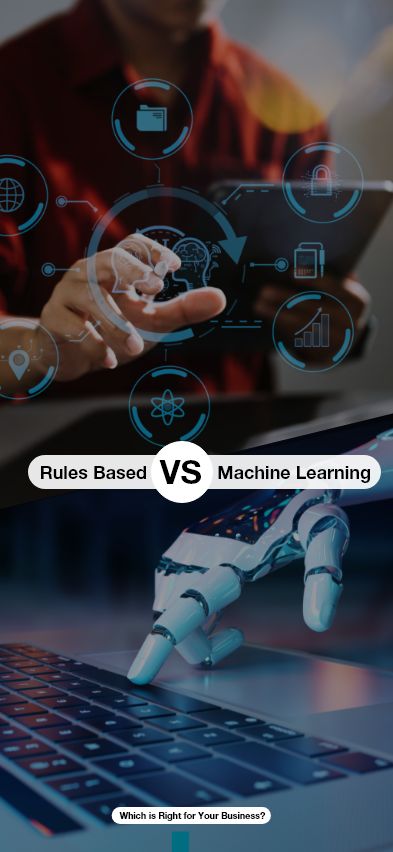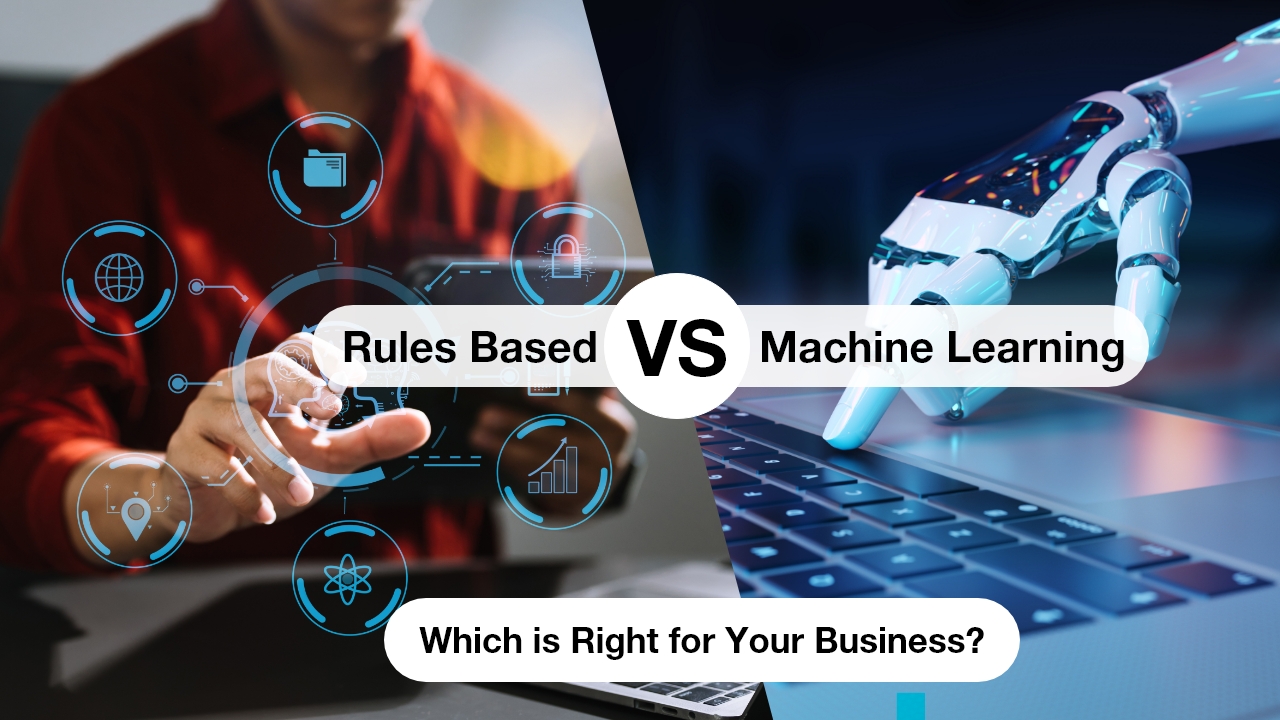

Posted On Aug 21 2023 | 17:57
To derive insights from data using artificial intelligence (AI), we typically employ either of two contrasting methods: rules-based or machine learning. Nevertheless, there are instances where combining these approaches can yield optimal outcomes. It is imperative to comprehensively grasp the merits and limitations of both technologies to discern the most suitable solution for your business needs.
What is a Rule-Based System in Artificial Intelligence?
A rule-based AI system is a type of artificial intelligence model that relies exclusively on predefined rules to achieve its intelligence. This straightforward approach involves a collection of rules crafted by humans, which dictate specific outcomes. These AI models operate based on conditional statements, often structured as “if X does Y, then Z is the outcome.” Key components of rule-based AI systems include a “rule set” and a “fact set,” which developers utilize to construct a rudimentary artificial intelligence model.
Rule-based AI models inherently exhibit determinism, functioning through a straightforward cause approach. This model possesses a rigid and non-expandable structure, limiting its capabilities exclusively to the tasks and functions it has been explicitly programmed to execute. Consequently, these rule-based AI models operate efficiently with minimal data and basic information tailored to their predefined operations.
What is a Machine Learning Model in Artificial Intelligence?
A machine learning model refers to a sophisticated AI system harnessed from the capabilities of machine learning (ML). These systems possess the unique ability to autonomously establish rules based on the data outcomes they encounter, devoid of human input. By exclusively relying on data-driven outputs or expert insights, ML models embrace a probabilistic methodology. This approach factors in uncertainties and likelihoods to generate well-informed outcomes. Consequently, these models exhibit a continuous evolution, growth, and adaptation as they integrate fresh information.
Serving as a primary alternative for overcoming the limitations of rule-based systems, machine learning (ML) systems are particularly employed to tackle hurdles like the efficient training of extensive datasets. These ML systems find utility in expansive ventures necessitating scalability. In stark contrast to rule-based AI systems, ML systems exhibit adaptability and agility, enabling them to manipulate data or values using flexible programming languages. The proficiency of ML systems in pattern recognition grows with the influx of data, rendering them increasingly accurate as they process larger volumes of information.
Advantages of Rule-Based Systems:
- Accurate cause-and-effect operation.
- Efficient with basic data.
- Quick, precise decisions.
Disadvantages of Rule-Based Systems:
- Limited scope, lacking learning abilities, leading to complexity with excessive rules.
- Immutability, hindered scalability, and challenges in rule modification.
- Restricted intelligence, reliant on developer-defined rules, prone to flaws and oversights.
Advantages of Machine Learning Models:
- Adapts with new data for informed decisions.
- Learns from patterns in diverse variables.
- Scales to handle growing complexity.
Disadvantages of Machine Learning Models:
- Quality of training data directly affects model performance.
- Complexity demands advanced technical expertise.
- Limited adaptability to unfamiliar situations.
Choosing the Right Approach:
- Deciding between rules-based AI and ML systems depends on your project's needs and goals.
Rules-Based Systems:
Rules-based systems are particularly well-suited for projects and applications demanding minimal data and clear, simple rules. Imagine them as purpose-specific tools, highly effective within their set boundaries, but less adaptable beyond. These systems excel in repetitive tasks with minimal human decision-making involvement, like fault analysis, triggered email routing, and basic searches.
Speed is a key advantage of rules-based systems, delivering rapid outcomes due to their restricted parameters. Moreover, their meticulous and comprehensive nature makes them valuable for error-intolerant processes like medical diagnosis and financial transactions.
Machine Learning Systems:
Machine learning (ML) systems come into play when dealing with substantial volumes of pertinent data, enabling more precise predictions. They excel in scenarios characterized by a multitude of variables, factors, and potential outcomes.
ML systems prove invaluable when tasked with forecasting results while lacking a clear methodology. For instance, they shine in areas such as evaluating sales leads and automating customer support responses—particularly in situations featuring intricate variables. As a result, ML systems find their optimal application in swiftly evolving domains like e-commerce recommendations and broad-scale forecasting.
A prime illustration of this lies in the autosuggestions offered by platforms like YouTube and Netflix. These systems leverage algorithms that learn from your interactions, adeptly discern your preferences, and subsequently propose content tailored to your inclinations.
Choosing Between Rule-Based and Machine Learning Systems:
The decision between employing a rule-based system versus a machine learning system hinge on several key factors. These include the level of stringency required for parameters, considerations surrounding efficiency and training costs, and whether the responsibility of crafting rules falls on a data science team or an algorithm.
Machine learning exhibits remarkable prowess in tackling intricate and demanding challenges, especially within environments characterized by variability. Conversely, rule-based AI systems offer a clear advantage in terms of interpretability and precision. It’s important to note, however, that the flexibility and swiftness inherent to machine learning systems do come with certain trade-offs. Embracing machine learning entails a heightened level of commitment, as algorithms necessitate substantial volumes of data to achieve effectiveness.
Training these algorithms can span significant durations, making a rule-based approach more sensible for simpler tasks. Rule-based systems find their sweet spot in scenarios devoid of excessively intricate decisions or massive volumes of intricate data.
While rule-based systems are typically straightforward, adding extra rules and mitigating factors can inadvertently create conflicts and redundancies. This intricacy becomes apparent when examining a situation like calculating the minimum experience needed for a job position. In a rule-based framework, HR professionals might set a rule stipulating a minimum of five years of relevant work experience. Nevertheless, in complex AI implementations, reality is seldom so uncomplicated. The greater the number of adaptations and refinements needed; the more convoluted rule-based systems can grow.
Shifting towards machine learning models becomes a prudent choice when the adjustments required in a rule-based system become overwhelming. Machine learning exhibits remarkable efficacy within dynamic and ever-changing scenarios, given its capacity for scalability and adaptability.
While establishing an algorithm, imparting training using pertinent datasets, and instilling the ability to discern patterns and correlations demands a substantial initial investment, the resultant model gains the capability to navigate through intricacies surpassing what a rule-based system can manage.
To elaborate on this concept, considering the HR scenario mentioned earlier, a machine learning approach could utilize iterative learning techniques to enhance the recruitment process. By employing backpropagation, the framework can progressively refine the hiring criteria based on data-driven insights. This dynamic approach allows the model to develop a more intricate and refined set of rules that take into account factors such as candidate’s skills, experience, and cultural fit.
However, it’s important to note that if the model aims to uncover novel or infrequent occurrences, such as detecting fraud, the availability of suitable examples for learning might be initially restricted. In such cases, the model’s performance can be hampered due to insufficient labeled data.
Summary:
Both rules-based and ML systems possess distinct strengths and weaknesses, contingent on your project’s demands. For precise outcomes within a limited framework, opt for rules-based systems. Conversely, when abundant data availability and predictive tasks are essential, ML systems offer superior solutions. In cases demanding both precision and extensive data processing for informed predictions, a hybrid approach might be the ideal choice to meet your business needs.
If you are looking for more technical detail on how to best choose which development route is best for you then we suggest reaching out to our expert, Adrian Wilson, at adrian.wilson@peopletech.com Adrian would gladly arrange a consultation to explore customizing our services according to your specific requirements.
